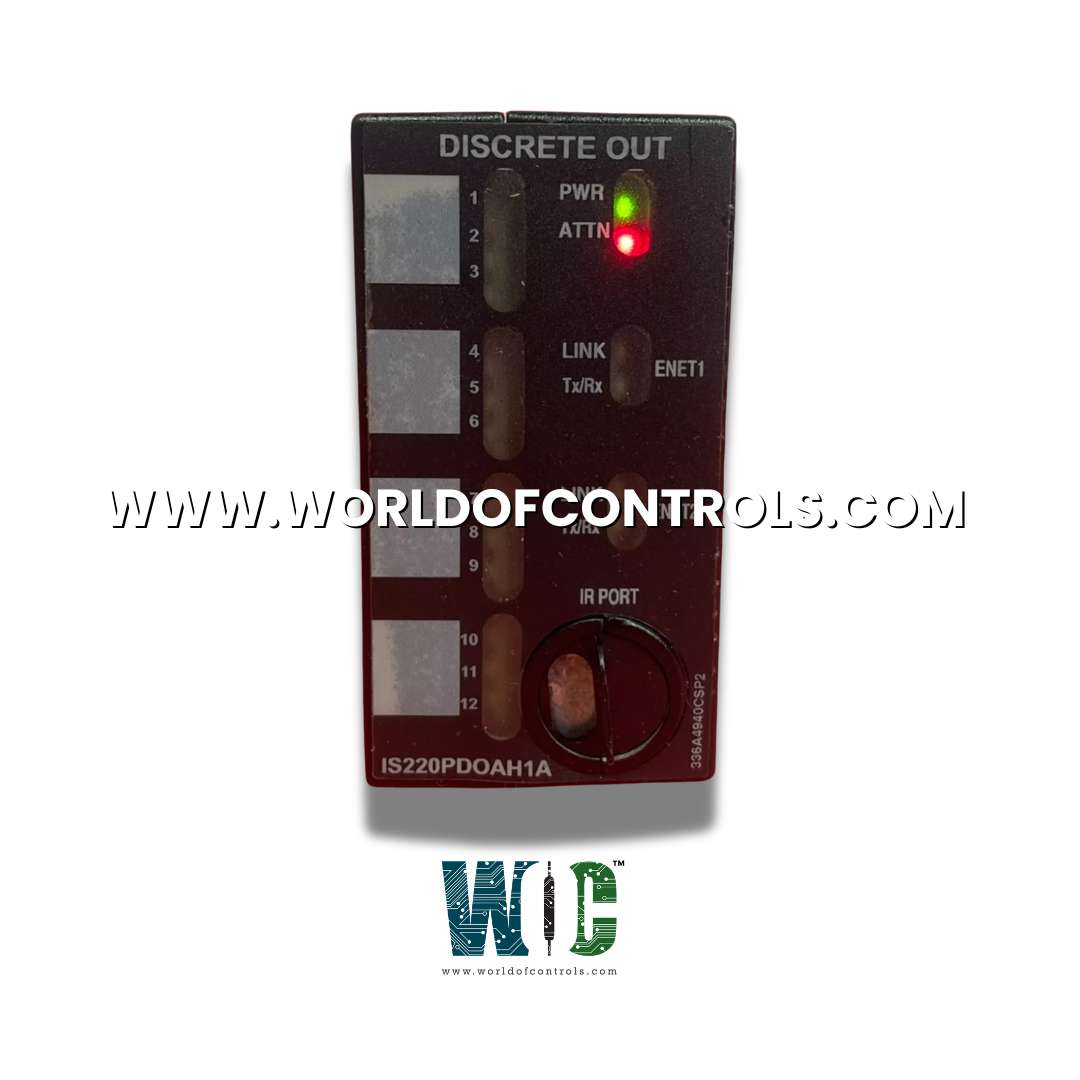
World Of Controls understands the criticality of your requirement and works towards reducing the lead time as much as possible.
IS220PDOAH1A, REV G - Discrete Relay Output Terminal Board is available in stock which ships the same day.
IS220PDOAH1A, REV G - Discrete Relay Output Terminal Board comes in UNUSED as well as REBUILT condition.
To avail our best deals for IS220PDOAH1A, REV G - Discrete Relay Output Terminal Board, contact us and we will get back to you within 24 hours.
SPECIFICATIONS:
Part Number: IS220PDOAH1A, REV G
Manufacturer: General Electric
Series: Mark VIe
Number of Channels: 24
Inputs: 125 V dc, 15A
Input Impedance: 4-20 mA
Input Converter Resolution: 16-bit A/D Converter
Product Type: Discrete Relay Output Terminal Board
Output Fuses 12 fuses: 250 Volt, 15 A
Output Converter: 12-bit
Temperature Operating: -30 to +65 C
Memory: 128 MB of flash memory
Ethernet: 10BaseT/100BaseTX (RJ-45)
Microprocessor: Intel Celeron 300 MHz
Size: 26.04 cm high x 1.99 cm wide
Repair: 3-7 Day
Availability: In Stock
Weight: 2 lbs
Country of Origin: United States
Manual: GEH-6721D
FUNCTIONAL DESCRIPTION:
IS220PDOAH1A, REV G is a Discrete Relay Output Terminal Board manufactured and designed by General Electric as part of the Mark VIe Series used in GE Distributed Turbine Control Systems. The PDOA serves as the electrical interface between one or two I/O Ethernet networks and a discrete output terminal board. It includes a processor board, common across all Mark VIe distributed I/O packs and a discrete output-specific acquisition board. The pack can manage up to 12 relays and supports terminal board-specific feedback. It is compatible with electromagnetic relays (used with TRLYH1B, C, D, and F terminal boards) and solid-state relays (used with TRLYH1E boards). Inputs are received via dual RJ45 Ethernet connectors and three-pin power input, while outputs connect through a DC-37 pin connector directly to the terminal board. Diagnostics are facilitated by indicator LEDs and an infrared port for local serial communication.
COMPATIBILITY:
The PDOAH1A supports six types of discrete (relay) output terminal boards, including TRLY and SRLY boards, but excludes DIN-rail-mounted DRLY boards. The compatibility details are outlined in the table below:
INSTALLATION:
OPERATION:
PDOA relay command signals perform initial signal conditioning and level shifting to connect terminal board outputs with the control logic. Each output uses an open collector transistor circuit with a current monitor to detect when it is activated and linked to a load. Status LEDs and monitor outputs provide feedback, indicating activation and connection to the terminal board. If the output is active but the expected load is not detected, the status LED remains off, and the monitor line returns false.
The PDOA includes power management in the 28 V input circuit. The management function provides a soft start to control current inrush during power application. After applying power, the circuit provides a fast current limit function to prevent a pack or terminal board failure from propagating back onto the 28 V power system. When power is present and working properly, the green PWR indicator will light. If the current limit function operates, the indicator will be out until the problem is cleared.
WOC has the largest stock of OEM Replacement Parts for GE Distributed Control Systems. We can also repair your faulty boards and supply unused and rebuilt boards backed up with a warranty. Our team of experts is available round the clock to support your OEM needs. Our team of experts at WOC is happy to assist you with any of your automation requirements. For pricing and availability on parts and repairs, kindly contact our team by phone or email.
What makes the Discrete Relay Output Terminal Board unique in signal conditioning?
The board integrates signal conditioning and level shifting, ensuring seamless communication between control logic and external relay-driven systems.
How does the terminal board handle incorrect load connections?
If the output is active but the correct load is not detected, the status LED remains off, and the monitor line signals false, enabling quick identification of connection issues.
What type of power input does the terminal board require?
The terminal board operates via a three-pin power input through the connected PDOA I/O pack, which regulates and delivers the necessary power.
How does the terminal board ensure proper alignment with the PDOA I/O pack?
Threaded studs and a mounting bracket ensure secure and accurate alignment, minimizing stress on the DC-37 connector and ensuring reliable performance.